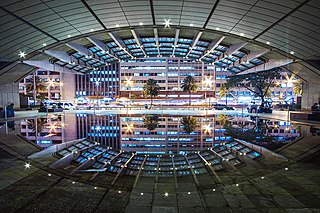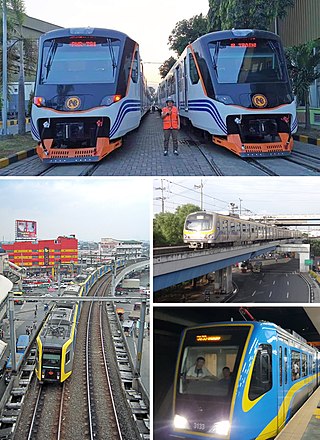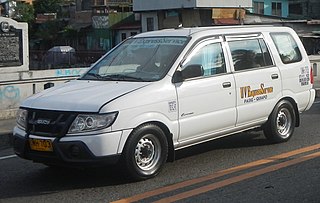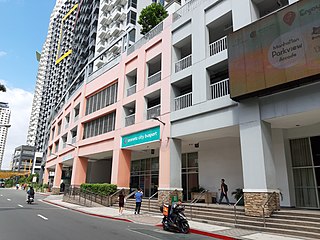
Transportation in the Philippines covers the transportation methods within this archipelagic nation of over 7,500 islands. From a previously underdeveloped state of transportation, the government of the Philippines has been improving transportation through various direct infrastructure projects, and these include an increase in air, sea, road, and rail transportation and transport hubs.

Metropolitan Manila, commonly shortened to Metro Manila and formally the National Capital Region, is the capital region and largest metropolitan area of the Philippines. Located on the eastern shore of Manila Bay, the region lies between the Central Luzon and Calabarzon regions. Encompassing an area of 619.57 km2 (239.22 sq mi) and with a population of 13,484,462 as of 2020, it is composed of sixteen highly urbanized cities: the capital city, Manila, Caloocan, Las Piñas, Makati, Malabon, Mandaluyong, Marikina, Muntinlupa, Navotas, Parañaque, Pasay, Pasig, Quezon City, San Juan, Taguig, and Valenzuela, along with one independent municipality, Pateros. As the second most populous and the most densely populated region in the Philippines, it ranks as the 9th most populous metropolitan area in Asia and the 6th most populous urban area in the world.

Makati, officially the City of Makati, is a highly urbanized city in the National Capital Region of the Philippines.

Rail transportation in the Philippines is currently used mostly to transport passengers within Metro Manila and provinces of Laguna and Quezon, as well as a commuter service in the Bicol Region. Freight transport services once operated in the country, but these services were halted. However, there are plans to restore old freight services and build new lines. From a peak of 1,100 kilometers (680 mi), the country currently has a railway footprint of 533.14 kilometers (331.28 mi), of which only 129.85 kilometers (80.69 mi) are operational as of 2024, including all the urban rail lines. World War II, natural calamities, underspending, and neglect have all contributed to the decline of the Philippine railway network. In the 2019 Global Competitiveness Report, the Philippines has the lowest efficiency score among other Asian countries in terms of efficiency of train services, receiving a score of 2.4, and ranking 86th out of 101 countries globally. The government is currently expanding the railway network up to 1,900 kilometers (1,200 mi) by 2022 through numerous projects.

The Department of Transportation is the executive department of the Philippine government responsible for the maintenance and expansion of viable, efficient, and dependable transportation systems as effective instruments for national recovery and economic progress. It is responsible for the country's land, air, and sea communications infrastructure.

Mandurriao is a district in Iloilo City, in the province of Iloilo, on the island of Panay, in the Western Visayas region, in the Philippines. It is the second-largest district by land area as well as the third-most populous district, with 62,240 people in the 2020 census. Mandurriao has emerged as the focal point of urban development in Iloilo City, gaining recognition as the future commercial and financial center, surpassing Iloilo City Proper.

The Metro Manila Skyway, officially the Metro Manila Skyway System (MMSS) or simply the Skyway, is an elevated highway serving as the main expressway of Metro Manila, Philippines. It connects the North and South Luzon Expressways with access to Ninoy Aquino International Airport via the NAIA Expressway (NAIAX). It is the first fully grade-separated highway in the Philippines and one of the longest elevated highways in the world, with a total length of approximately 39.2 kilometers (24.4 mi).

Taxicabs of the Philippines are one of the modes of transportation in the country. They are regulated by the Department of Transportation (DOTr), the Land Transportation Office (LTO), and the Land Transportation Franchising and Regulatory Board (LTFRB). The taxicabs there vary from models and uses. Most taxicabs have yellow colored license plates, taxi signs, LTFRB Registration number, and taximeter, which is mandatory in every cab.
Juaymah Maureen Transport (JMT) is a bus company owned and operated by a Filipino family from Las Piñas. It plies routes from Alabang in Muntinlupa to Lawton and Quiapo in Manila and sometimes to Ayala in Makati.

JAC Liner Inc. is one of the largest bus companies in the Philippines serving the riding public en route to Southern Luzon provinces which includes key destinations in the provinces of Laguna, Quezon and Marinduque.

The transportation system in Metro Manila covers the road network, rail network, ferries, ports and airports located with the metropolitan Manila area. Road transportation in Metro Manila is diverse, composed of many types of private and public transport vehicles. These include Taxis, buses, jeepneys, tricycles and pedicabs. In some areas, especially in Divisoria and large public markets, two-stroke motors are fitted in the pedicabs and are used for goods transport. Regardless of modernity, horse-drawn kalesas are still used in the streets of Binondo and Intramuros. Ridesharing services such as Grab also operate within in Metro Manila.
Citylink Coach Services Inc. is an intercity bus company in the Philippines operated under First Oceanic Property Management Inc., an affiliate company of Megaworld Corporation. It plies routes from Eastwood City, in Libis, Quezon City to Newport City, in Villamor Air Base, Pasay via C-5 Road, making the first bus company to traverse along the said road. This company offers shuttle services only for those who are working to the companies operated under Megaworld Corporation.

Senator Gil J. Puyat Avenue, also known simply as Gil Puyat Avenue and by its former official name Buendia Avenue, is a major arterial thoroughfare which travels east–west through the cities of Makati and Pasay in western Metro Manila, Philippines. It is one of the busiest avenues in Metro Manila linking the Makati Central Business District with the rest of the metropolis.

UV Express is a license to operate utility vehicles, particularly vans, as an alternative mode of public transportation in the Philippines. The term also refers to the vehicles themselves. This is one of the two types of share taxi services in the Philippines with the bus-like Jeepney. There is new law about transport franchising. Transport Cooperative thru the government office of the Cooperative Development authority.

The Makati Central Business District is a financial and central business district in the Philippines located in the heart of Makati in Metro Manila. It is politically known as "Central Cluster" in the West District of Makati. It is different from the Makati civic center known as "Makati Poblacion" which is situated at the northeast portion of the district. It is bounded by EDSA, Amorsolo Street, Ayala Avenue, Gil Puyat Avenue, Osmeña Highway, Zobel Roxas Street, Ocampo Street, Metropolitan Avenue, Nicanor Garcia Street, Kalayaan Avenue, Makati Avenue, Anza Street, Polaris Street, Orion Street, Mercedes Street, Amapola Street and Estrella Street. The whole district occupies barangays of San Antonio, San Lorenzo, Bel-Air, and Urdaneta.

Hype Transport Systems, Inc. is a vehicle for hire company established in the Philippines in 2018. The Land Transportation Franchising and Regulatory Board (LTFRB) accredited the company as part of efforts by the Philippine Department of Transportation to promote competition with Grab. A feature that distinguishes Hype from Uber and other services that use mobile apps as their primary access point is that Hype Transport allows the use of older SMS technology as an alternative means for customers to use the service.
The Santa Rosa Integrated Terminal (SRIT), also known as the SM City Santa Rosa Transport Terminal, is a bus station in SM City Santa Rosa in Santa Rosa, Laguna, Philippines. It is the second of three planned provincial intermodal terminals for the south of Manila under a public-private partnership arrangement. Opened on March 26, 2019, the terminal handles province-bound and incoming buses from Calabarzon and the Bicol Region, as well as other provincial buses plying the nautical highway in the south pending the completion of, and as an alternative to, the Taguig Integrated Terminal Exchange.

The Araneta City Bus Port (ACBP), also styled Araneta City Busport, is a bus station in Quezon City, Metro Manila, the Philippines. The bus station is currently one of two bus terminals in the Araneta City business district that link Metro Manila with the provinces in the north and south of the country, including cities in the Visayas and Mindanao via the Philippine Nautical Highway System.
















